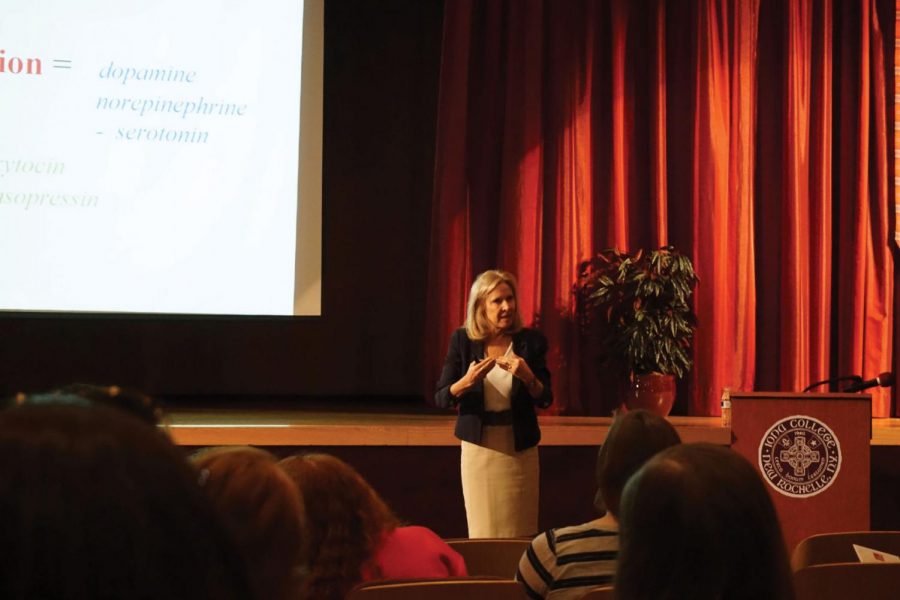Match.com scientist gives presentation about the biology behind love in visiting lecture series
October 14, 2016
Iona College welcomed biological anthropologist Dr. Helen Fisher in the Murphy auditorium on Oct. 4. Fisher, a senior research fellow at the Kinsey Institute of Indiana University, a member of the Center for Human Evolutionary Studies in the Department of Anthropology at Rutgers University and Chief Scientific Advisor to Match.com came to present her research as part of the Jack Rudin & John G. Driscoll Distinguished Visiting Professorship.
Dr. Fisher’s presentation, entitled “Lust, Romance, Attachment: The Drive to Love, Who We Choose and the Future of Love in the Digital Age” gave students and faculty insight into what draws us to one person rather than another.
She began by asking the question that was constantly on her mind when she started working with Match.com.
“People will say ‘we have chemistry’ or ‘we don’t have chemistry,’ what do they mean by that?” Fisher said.
The three components that make up the brain system of love are sex drive, romantic love and attachment. Fisher focuses her research on romantic attraction, mainly the brain systems that are active when somebody is in love.
She explained that the development of romantic love starts when a person takes on special meaning. He or she is somehow better than anybody else and anything that the person might not like about him or her is ignored, and the focus is given to what is desirable. Next comes intense energy. People are extremely happy when things are going well, but when things do not, they sink into a deep feeling of despair. Bodily reactions, such as butterflies in the stomach or weak knees, are part of the energy felt whenever that special someone is around. Lastly, people in love develop separation anxiety, and a sense of possessiveness over their loved one. Fisher coined the term “frustration attraction” to describe the sensation of wanting someone even more when he or she is unavailable.
Aside from observing behavior, Fisher uses MRI scanning technology to look at the brain activity of people who are in love. She and her research team scanned the brains of people who were married for an average of 21 years, and they all had brain activity in the Ventral Tegmental Area, or the VTA. The VTA produces dopamine which creates the feelings of elation, craving, romantic drive and euphoria that is experienced as part of romantic love.
Fisher also looked at the brain scans of people who had recently been rejected in love. Through the MRIs, Fisher determined that the same brain regions that are active when a person is addicted to something- like alcohol, nicotine, cocaine, gambling- were also active in these people, suggesting that love is an addiction. She also found that people who were in pain over being rejected had activity in the same part of the brain that causes tooth pain.
After observing what occurs in the brain when somebody is in love, Fisher still wanted to know why someone is attracted to certain people over others. She said that psychologists claim people are attracted to others due to timing, proximity and similarities in intelligence, financial background and attractiveness along with other factors. However, Fisher pointed out that in a place like college, where a majority of people have similar intelligence levels, financial and educational backgrounds, we do not fall in love with everyone we see. She began to think that biology might play a role.
To confirm her theory, Fisher read biological literature in order to find any trait linked with a biological system. She found four brain systems that are linked with personality traits: dopamine, serotonin, testosterone and estrogen. She created a questionnaire that she posted on Match.com and Chemistry.com in forty countries and she received 14 million responses. After taking the survey, a person found out if he or she is a Builder, Explorer, Director or a Negotiator, all of which are linked to serotonin, dopamine, testosterone and estrogen brain systems, respectively. She saw patterns attraction, giving her some of the answers to why we are attracted to one person rather than another.
Fisher also showed evidence that love can last. By scanning the brains of older, married people, she found brain activity in regions linked with empathy, controlling one’s own stress and emotions and positive illusions. Meaning, being in love for so long has helped these people to have a positive outlook on things.
“I don’t believe anymore in the golden rule, ‘do unto others as you would like done unto yourself’,” Fisher said. “I believe in the platinum rule, ‘do unto others as they would like to have done unto themselves.”








